Learning how to start plants from seed is not difficult, saves money, and gets a jump start on the growing season. Not to mention the sense of satisfaction seeing those tender green shoots spring up in the midst of a lingering winter.
This post may contain affiliate links at no additional cost to you. By making your purchases through the links on this website, IMSL may make a small percentage at no direct cost to you. IMSL only promotes products we use & truly believe in. Please refer to my Privacy & Disclosures for further information. IMSL thanks you for your support!
So you’ve decided you want to give a go to growing your own garden from seed. How awesome is that? Gardening organically is so beneficial on every level, feeding the soul, the earth, & yes, even yourself with each harvest.
It always amazes the bounty we receive starting out with nothing but one little seed. With a little planning & timing, a few supplies, and a little know-how, you will be enjoying the fruits of your efforts in no time.
WHY GROW FROM SEEDS
Living in the NE, the winters are long & the cold can be brutal. The gardening season is a bit shorter here in Zone 5a area that I live in. You can find your gardening zone here to determine the best timeline for planting in your area.
As some plants are slower growing than others (a general list is provided below for your convenience), planting or starting from seed indoors will give them the added boost of additional growing time, allowing the gardener to reap all its beauty & fruits within an appropriate time frame.
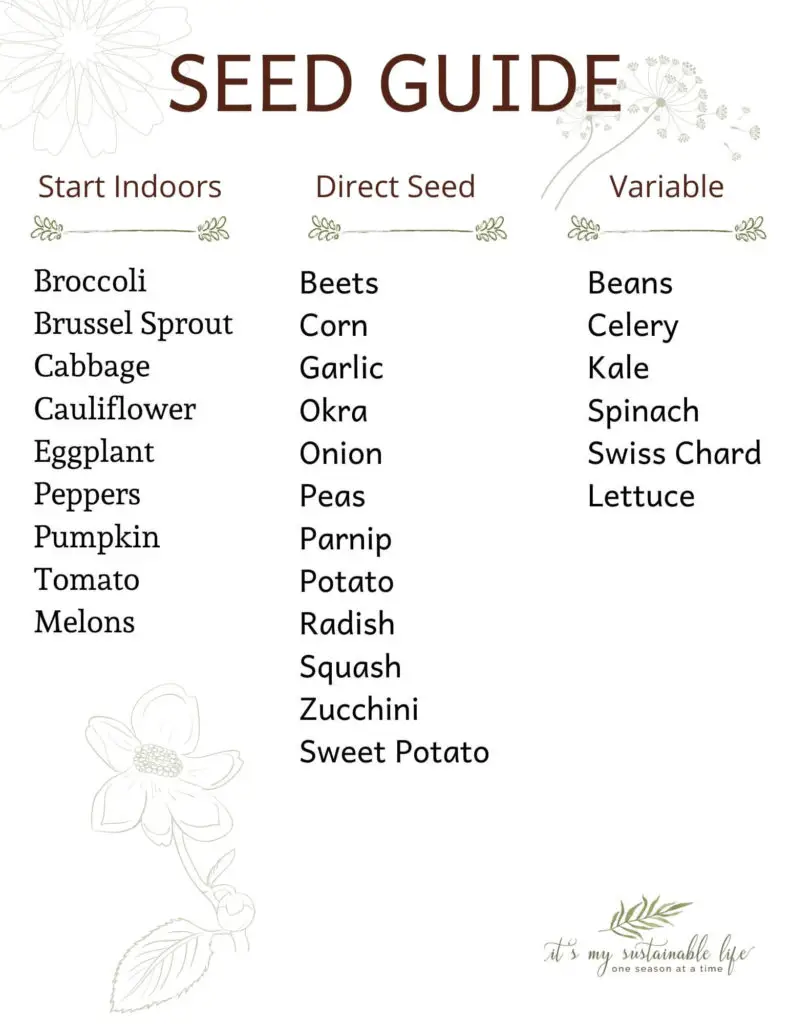
The beauty of growing from seed is you are in control of the “type” of seed you are willing to plant. End results of successful gardens largely depend on choosing the best seed you can source. For us here at IMSL, that means organic, heirloom, or seed we have saved here on the property.

If you have not already taken a look, be sure to visit the following articles in regard to sourcing your seeds!
SOURCING ORGANIC SEEDS
- Vegetable & Herb Seeds – Know The Differences
- It’s My Favorite Time Of Year – Buying Heirloom Seeds
- When Life Hands You Heirloom Seeds Just Plant ‘Em!
Being able to grow food organically from seed will save hundreds of dollars per year! Although plants can be purchased through your local nursery or farmer, the cost is far more for one plant that that of a packet of seed that will grow many plants. That alone is why many grow their gardens from seed & is one of the most popular reasons to choose this route.
There is nothing like getting dirt under the fingernails & hands in the soil when the weather is still blustery outside. There is something elemental and rewarding about playing in earth’s sandbox 🙂 The fact we can start our plants from seed 6-8 weeks prior to the growing season here in the Northeast means we get to play a little sooner 🙂
WHEN TO START SEEDS INDOORS
Most plants will need to be started between 6-8 weeks prior to your last frost date. As with anything, there are a few exceptions to that rule, some herbs & flowers especially are slower growing and need an earlier start date.
To determine an approximate “last frost date” in your gardening zone, go to The Old Farmers Almanac and simply input your zip code. This often is not exact, but will give you a guideline as to when to start your seeds indoors.
WHAT SEEDS TO START INDOORS
As shown in the seed guide above, not all seeds need to be germinated indoors. There are some varieties that prefer to be sown directly into the ground and grow sufficiently during the time needed to mature.
Varieties such as root vegetables (beets, carrots, & radish, etc) do very well when left undisturbed by transplanting. That being said, great success has been made here when thinning varieties such as beet and carrot and transplanting those thinnings. Be sure to check out “Thinning Carrots The No Waste Way” for a complete tutorial on how.
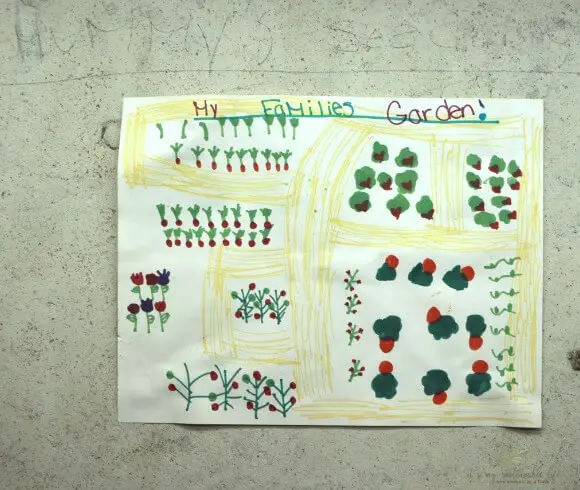
There are varieties that are considered “variables” that may be sown either indoors or directly into the garden and do very well. These varieties consist of lettuce, greens, & beans, etc. One benefit of starting the plants early is you get to enjoy the results earlier. The choice is up to you, however, why make the wasted effort of growing indoors when they grow fast & easy directly in our garden in our humble opinion.
BEST CONTAINERS FOR STARTING SEED INDOORS
Deciding which container system to utilize is a personal one. Everything from elaborate grow systems, trays, and lighting can easily be purchased, set-up & ready to go. However, a large investment does not need to be made when growing from seed indoors.
As you can see from the system we have in place, in our cellar of all places, it has worked efficiently for us for the past 16 years.
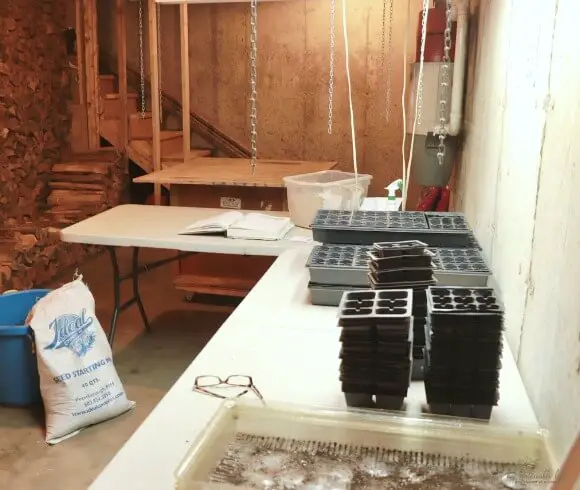
Utilizing what’s on hand, re-purposing & re-using existing pots, and the investment of a few grow lights & heat mats and we are ready to roll. The small, one-time investment of this equipment has kept us growing for many years.
There are many ways for sourcing pots to use for your seedlings. Everything from making your own out of newsprint, to recycling containers you have on hand. Check out “Alternatives For DIY Seed Planting Pots” for many ideas that are free or at least very inexpensive.
For us, re-using our existing trays, cells, and dome covers work more than efficiently. Once I sterilize these, they are good to go!
STARTING SEEDS INDOORS SUPPLY LIST
To grow your plants from seeds indoors you will need a few basic supplies.
- Seeds
- Seedling pots and/or containers of your choice
- Growing medium
- Labels
- Light
- Pencil & Sharpie or waterproof marker
- Recommended – Gardeners Journal or Seed Planting Worksheet
Sourcing your seeds has been covered. Again, we highly recommend heirloom or organic varieties, but at the very least non-GMO options should be chosen if possible.
Our ideal seedling starter pots are what you already have on hand as discussed earlier. Regardless of the type of seedling pot chosen, consideration should be made to include trays to catch water runoff, preferably with domed lids. Once the seeds are planted, the domed lids create a greenhouse effect, keeping moisture & heat in, ensuring good germination rates.
Creating a labeling system is highly recommended when planting your seed. Again, it does not have to be expensive. We utilize popsicle sticks that we cut in half, labeled with the variety name, and placed in each cell. Very inexpensive, sustainable, and works well.
Some form of lighting will be needed unless you are fortunate to live in a warm sunny climate. Using a light source with reflector, like the examples shown above, is a great way to make sure those seedlings are receiving the light they need to thrive.
Our lights are 4 feet wide, allowing me to place 2 trays side by side lengthwise, letting the full tray be exposed to the light evenly. We’ve hung these lights from the rafters of our basement with chains that can be easily adjusted in height. Starting out at 1-2 inches above the dome and raising the height as needed for growth.
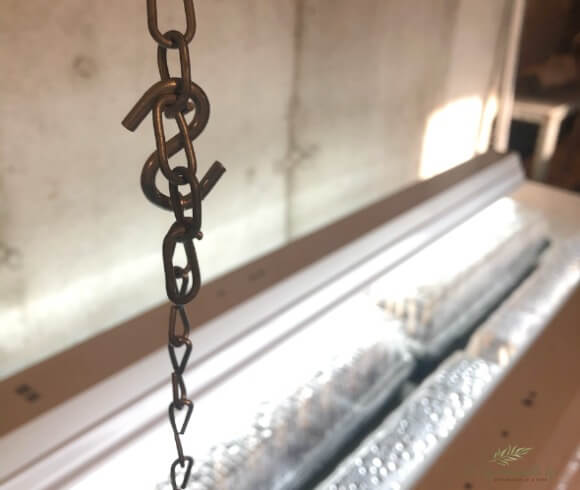
BEST SOIL OR MEDIUM TO GROW PLANTS FROM SEED INDOORS
Seed starter growing medium is needed to grow seeds indoors. You can purchase a pre-made seedling mix, but it can be a bit pricey. It is of most importance that the medium you use is sterile, fresh, & light enough to allow for those tender roots to develop.
To make your own soilless starting mix combine 2 parts compost, 2 parts coir (coconut husks), and 1 part perlite. Store this mix in a sealable container in a cool dry place. This is relatively inexpensive to make in comparison to pre-made mixes.
Another option is to mix fresh, bagged potting mix with an organic starter mix. We do not recommend using strictly bagged potting soil as this can be too heavy a mix for growing seedlings & does not retain moisture effectively. We mix a bit of organic bagged potting soil along with an organic starter mix to create a nice lite medium; about a 1:4 ratio, and have found this to work very well.
Straight soil from your garden (not sterile) should never be used as it may contain disease & other unwanted pests.
Care should also be taken to not use fertilizers of any kind during the initial stages of growing from seed as it can burn, harm and even kill tender growth. Seeds are an amazing creation and contain all they need for the first few weeks of life right in one tiny little package!
TESTING YOUR SEEDS FOR VIABILITY
Prior to planting your seeds, unless your seed stock is brand new, it’s always a good idea to test the seed for viability. Viability according to “How To Test Seeds For Viability” is a seed…
that will germinate when the right conditions or environments are created.
IMSL
There is nothing any worse than going through all the steps correctly and waiting. And waiting. And waiting. And, nothing! Be sure your seeds will germinate if you are using older seed stock well in advance of your seed starting date.
HOW TO START SEEDS
Starting your seeds indoors is fun & easy. Follow these simple steps and you will be enjoying some green in just a few days!
As with most projects, begin by gathering your supplies & set up an area that will work for you. We set up a work area, a couple simple 6 ft tables with our grow lights installed from the beams hanging over the table. It’s simple, out of the way, and works well.
We highly recommend utilizing a gardening journal year to year. The one we have used for many years allows me to track not only the varieties & number planted but also garden layout (as we rotate our crops yearly in our gardening space), weather & pest/disease issues, as well as harvest numbers.
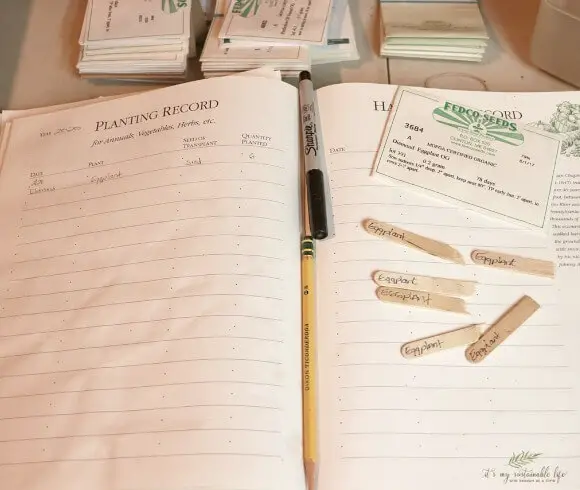
If you would like to create your own binder with your planting lists, we have created a beautiful Garden Management Planner filled with 25 printable pages that can be reused year to year!
And did I mention, they are gorgeous? Visit our Etsy Shop to grab yours!
Create your seed-starter mix and place it into a waterproof container or tub. Add water to create enough moisture in the mix to allow for the medium to hold together easily when squeezed in your hand.
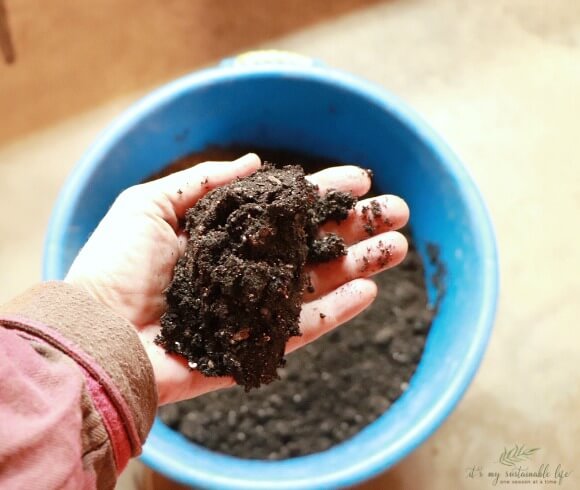
Fill your seed starting pots. Do not press or compact the soil into the pot or cells. It’s helpful to give the container a good tap or shake to allow the soil to settle.
Read the seed packet for directions! All seeds are not created equal, therefore, oftentimes directions for sowing are unique. The seed packet will tell you the depth to plant, spacing, germination information, light needs, growth habits, and so much more! Trust this information & use it 🙂
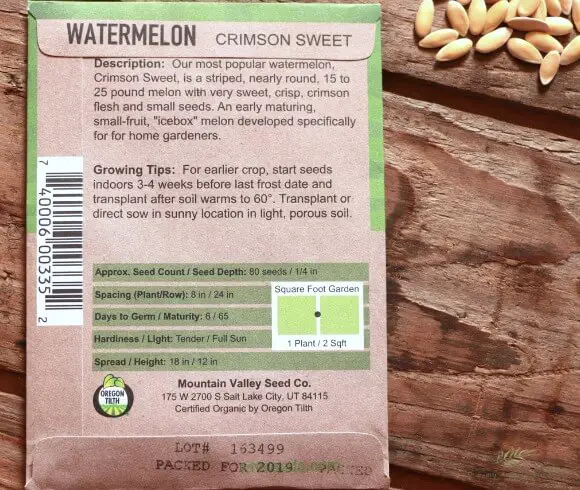
Take the pencil eraser end and press a small hole (typically 1/4 inch deep) into a cell. Always follow the directions for planting that is listed on the seed packet. More on this below. This will be the hole used to drop the seed(s) into.
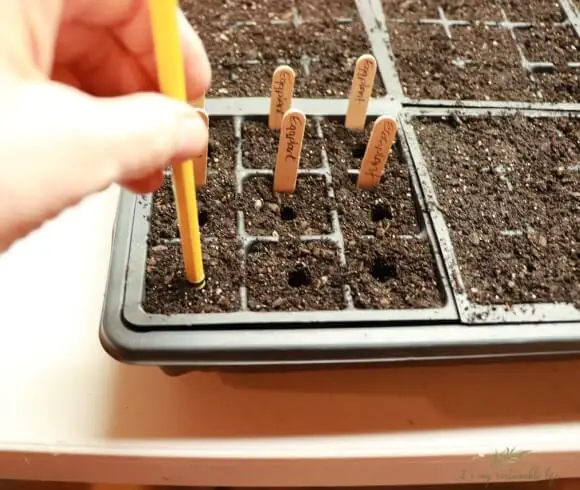
Once you’ve added your seed, gently cover the seed with the surrounding soil by pinching the soil together over the seed, unless the directions on your seed packet differ (some seed needs light to germinate). Very gently press the soil down on top of where the seed was planted to ensure good contact between seed and soil. DO NOT compact the soil, seeds like a light & fluffy existence initially!
How many seeds to you plant in each cell? That is up to you. Personally, if the packet is new, the viability rate should be listed on the seed packet, 80% germination rate on the Fennel seeds shown below (listed above the year).
That, in my opinion, is a pretty good success rate. I would only plant 1-2 seeds in each cell. Some say to never plant “just one seed” as this is taking a leap of faith that the seed will germinate successfully. I’m somewhat of an optimist and often plant “just one” 🙂
That being said, I do plant more cells than I will actually need in my garden. This gives added insurance that there will be enough plants I need when the time comes, and allows for a few casualties 🙂 If nothing else, seed is very inexpensive and you will have plants to share!
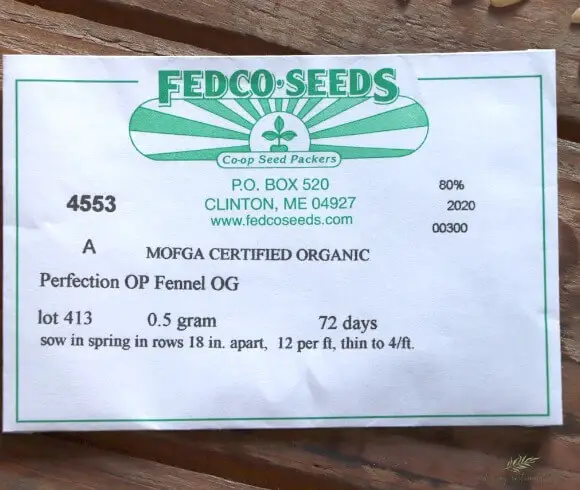
Write the name or variety of what you planted on your marker and place it into the cell or pot. I recommend doing this for each individual cell and not by grouping. It is very easy to mix up your varieties and the marker is ready to transfer to your next larger size pot when transplanting time arrives.
Once you have completed your planting, cover the trays with some form of clear material. Dome covers that come with many seed planting trays work very effectively as does clear plastic wrap. When using plastic wrap, loosely cover the planted trays or pierce several holes in the wrap for ventilation purposes. We prefer the covers as they can be sterilized and re-used year to year.
Successful germination requires a moist environment. Using covers to create a greenhouse effect will greatly assist in this. Check your seedlings daily to be sure they don’t dry out. If need be, remove the cover and mist the soil to keep moist but not overly wet. Keep the dome or cover on until germination has occurred.
Remove the dome for a brief time to check the moistness and control the humidity to prevent “dampening off”. Dampening off effects tender seedlings that usually have not produced their first “true leaves” or mature leaves & therefore do not have the ability or strength to fight off this fungus. But note, dampening off can occur at any stage of growth.
There are many reasons that this fungus may occur, largely due to “a fungus or mold that thrive in cool, wet conditions”, but according to University of Minnesota Extension,
Once plants have mature leaves and a well developed root system, they are better able to naturally resist the fungus or mold that causes damping off.
UMn
USING HEAT FOR GERMINATION
A quick note on using heat for germination and starting your seeds indoors. A few plants love heat and require it to successfully germinate. If your house is cool, 70 F or cooler, you will want to consider using a heat mat to maintain an optimal temperature of 70-80 F.
Optimal germination occurs when the soil maintains an even temperature of 70-80 F. That is for most plants. Cool crops such as lettuce, radish, and peas like it, well, cool, and would not need the use of a heat mat.
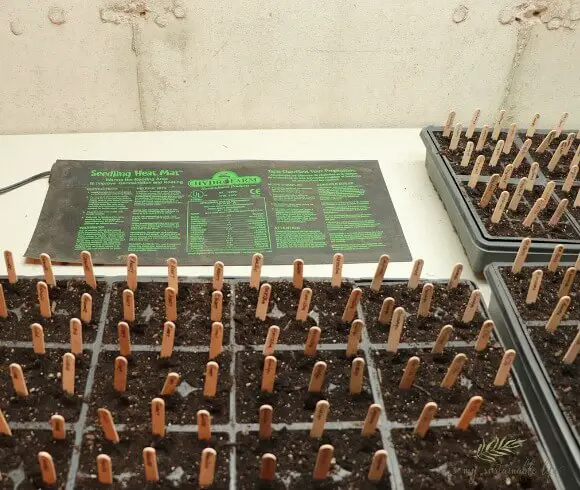
Using a heat mat under most seed trays will increase germination rates. If you choose or cannot use a heat mat, place the trays in a warm, draft-free, location such as the top of the refrigerator or a sunny warm space.
LIGHT REQUIREMENTS FOR STARTING SEEDS INDOORS
Although it is said that seeds do not require light until germination has occurred, with a few exceptions, I put the lights on them right after planting. Personally, I found that my germination rate increases somewhat as in my mind this mimics a natural environment of growing in nature.
That being said, experiment what works best for you when using grow lights. Regardless of your approach, once the seeds have sprouted, they need a light source. If you choose to use artificial lighting, the light needs to be positioned as close to the sprouts as possible, within 1-2 inches, and raising it slightly as they continue to grow.
Keep an eye on those sprouting plants. You will know if they have insufficient lighting, either too far away or too weak, as they will lengthen & become “leggy”. Not an ideal outcome.
If the sprouting plants begin to “lean” in one direction, they are seeking more light. It’s helpful to rotate the trays under the lighting so each cell gets it’s fair share of direct light. Typically, they will need to be exposed to a lighting source for roughly 12 hours each day. A timer can come in very handy when using artificial lighting.
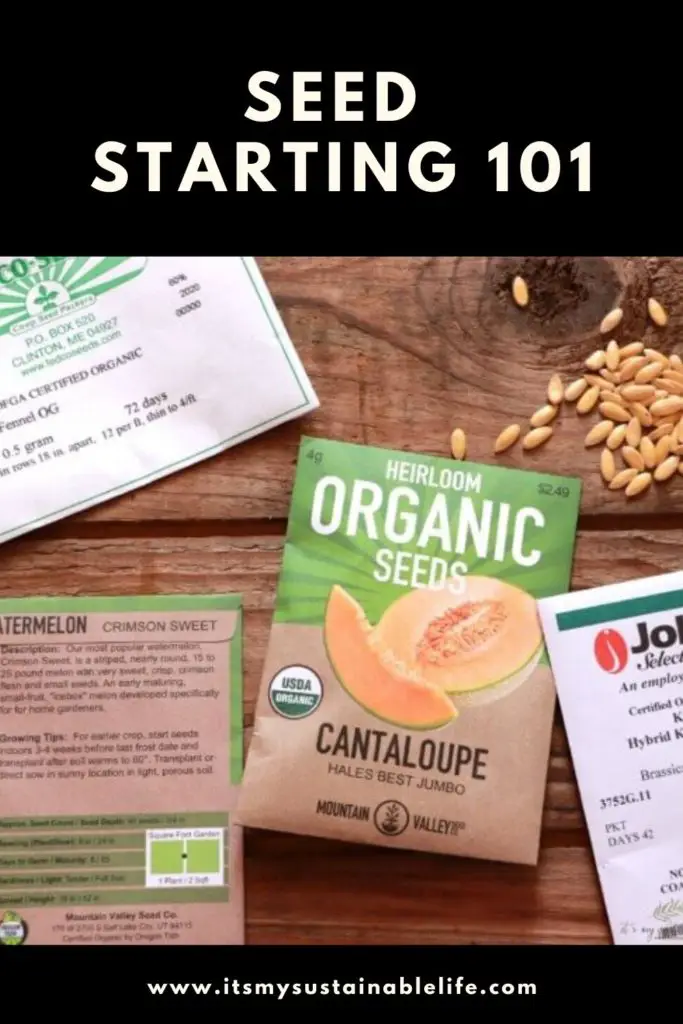
HOW TO CARE FOR YOUR EMERGING SEEDLINGS
Once the seedlings have emerged, remove the covers. Many like to set up a fan to create good air-flow. We have never found this to be a needed step, but if you don’t have an area that has good air-flow then you may want to consider a fan to gently create & mimic outdoor airflow & reduce the risk of dampening off.
Watering from below is highly recommended once those seeds have sprouted. Again, by watering from below reduces the risk of mold & fungus diseases from occuring. Keep the sprouting plants moist, like a damp spunge, but not overly wet. You will want to check the moisture on a daily basis, or in our case as our house is very dry (we heat with wood) twice a day.
Two weeks after germination or sprouting, once the plants are well established , you will want to begin fertilizing them. We use a liquid kelp solution and add it to our water.
Obviously, the plants will continue to grow. If you have used the flats or small cells such as we have, they will need more room to expand and grow. Thus, they will need to be transplanted into larger containers at that point. You will know they need to be transplanted when the roots begin to grow & show on the bottom of the cells or they “look” too big for their britches in their present space.
Be sure to keep you eye out in the next few weeks for an in-depth article on caring for your seedlings!
With a little planning, and a few supplies, growing your plants from seed indoors is an easy, inexpensive, and fun way to get your hands into the earth a bit earlier than mother nature allows.
Need access to more assistance for growing your garden? Join IMSL’s FREE facebook group, Organically Rooted Garden Group and have instant access to gardener’s knowledge of all levels! From beginner’s to master gardeners, this group was created as a resource to ask, share, and learn from one another! Hope to see you there 🙂
Do you begin your plants from seed already? Join the conversation below and let us know your tips & tricks to planting from seeds! Happy growing!!
Love, Light, & Laughter ~


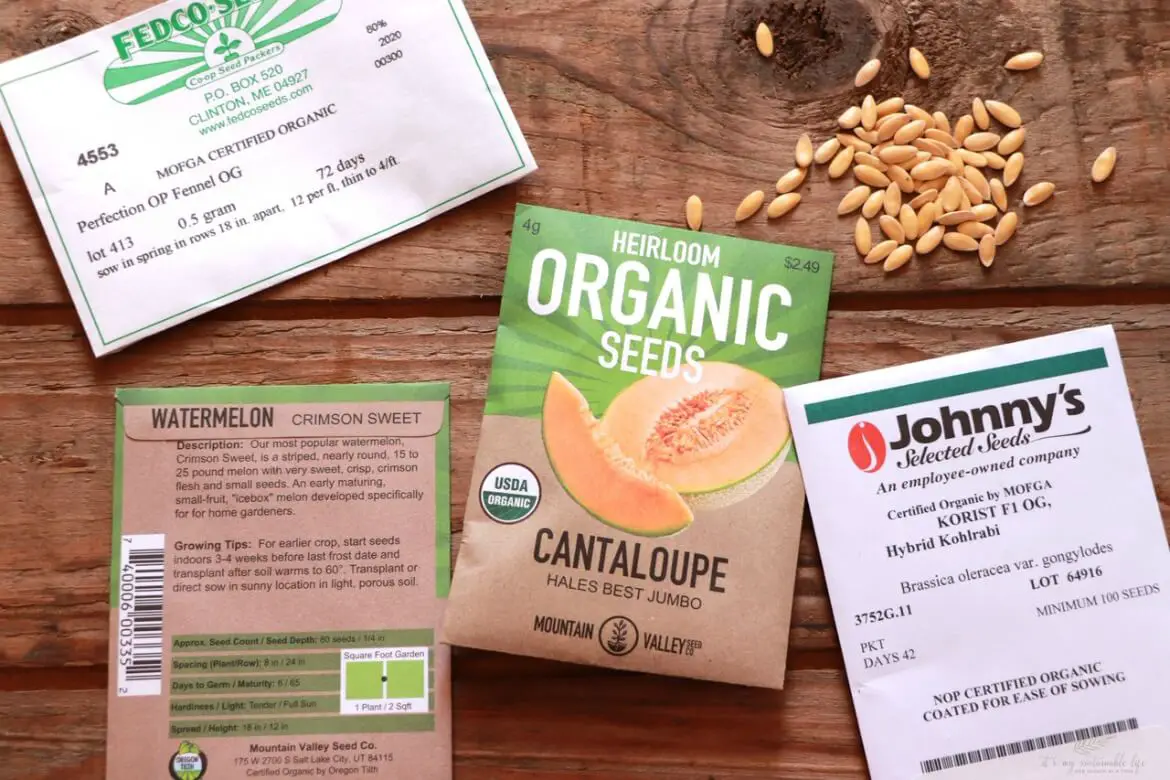
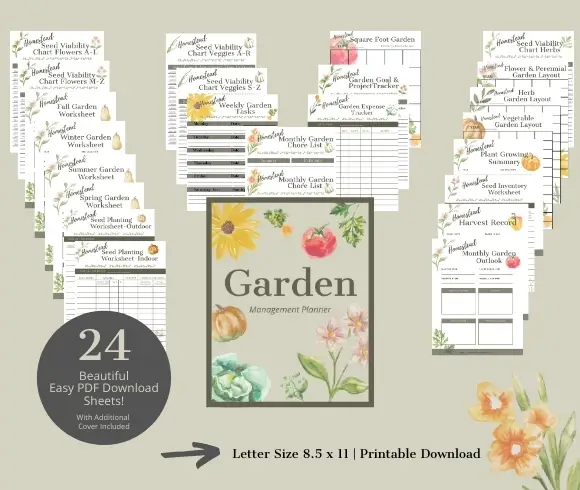

50 comments
Great post! I need to get some grow lights, I usually start seeds on my kitchen counter and our kitchen is overtaken through February and March! When we lived in the city we started seeds in our basement with lights, so much less mess!
I’m optimistic too Suzan and sometimes only plant 1 seed! I have had pretty good luck with most! Joining you from the Farm Fresh Tuesday Hop!
Thanks for the great post, Suzan. I always have a hard time starting plants from seed – my fault really, I either don’t water them too much or I overwater them and they get mold! This post is one of my picks for the Featured Posts on this week’s Simple Homestead Blog Hop – make sure you come back this week and add some more! There’s also a “This post was featured on..” picture that you can put in your side bar, to proudly display that you were featured.
I have never had much success with starting seeds indoors, but your directions sound very doable.
SO many great instructions. I love the seed guide. A quick reminder for what needs extra time, especially in my zone. Thanks for sharing on the Homestead Blog Hop!
Excitiing times!!! We have a greenhouse and plant our seeds, too. My time has been taken up restructuring my lessons for my students, but I hope to get out there and start me seeds this week. I don’t want to go to much later. Thank you for your tips!!
Oh, I envy the greenhouse! Happy planting!!
Wow, there is so much information here…this is great!
Thank you for sharing at #OverTheMoon. Pinned and shared. Have a lovely week. I hope to see you at next week’s party too! Come party with us at Over The Moon! Catapult your content Over The Moon! @marilyn_lesniak @EclecticRedBarn
Hi Suzan,
I love this; thank you for all the seed starting information! I’ve already started our tomato seeds indoors and am super excited to start planting this year. Thank you for sharing this post with us on the Homestead Blog Hop!
-Cherelle
Your postS are always so thorough and easy to follow! Tons of great information!
Great informative post! I’m so excited that the growing season is upon us! I’ve been out prepping in the garden.
Oh, I’m jealous! We are still waiting for the ground to fully thaw and dry a bit. Getting a bit antsy for sure!
Wow Suzan, you really know your craft! I’m just amazed about how thorough you are. This is a great way to motivate people to plant – from farm to table. Great post as always.
So glad you enjoyed it, Jane!
I love all of your gardening posts!
Thank you! I love that you enjoy reading them 🙂
You are so detailed with your directions. I’m almost convinced that I could turn my brown thumb green simply by reading your blog. I love the light demonstration.
Thank you for all of these tips on what seed to start when! Now I want to grow a garden just to be able to plant melon like my Grandpa used to do.
Thank you for sharing this information! I pinned for later, as next year I will hopefully start my garden!! 😀 Building our house this year, and very excited to start gardening!
Another informative post about seed starting. I’d like to explore your place and all the projects you have going on, it sounds interesting.
Wow, this is so comprehensive. I never realized how much goes into starting plants from seeds. I’m definitely the “buy a plant from the store” person. And all of my garden adventures have pretty much failed except for a few things. Like basil! lol. After reading all this, it’s probably in part due to me not doing enough research and putting more time into it.
This really is a fantastic guide to help start a garden! I will certainly refer back to ot when we figure out what we will fo about a garden this year!
Love the list at the top on direct seed, start indoors, etc! Just what I needed, thanks
GREAT information. I was just thinking of attempting this this year but wasn’t sure what the proper steps and equipment would be. Thanks for this awesome post!
Great information. I love starting my seeds indoors. Bring on spring.
Your posts are always so informative. You put a lot of love and care into your garden and it shows. Thank you for sharing with us all.
Very informative! I can’t wait to have fresh vegetables from the garden.
I definitely want to start some seeds indoors, and it’s just about that time. Thank you for the reminder and the excellent information. I’ll definitely be coming back to this. You really know your stuff!
Ha! I knew I was going to be ashamed of how I started my garden this year when I saw this article. I direct seeded ALL of my tomatoes. I was on a time crunch and used seeds from tomatoes we were eating and just got them in the dirt. Everything is growing great but it is a little chaotic, Very crowded and I was not sure it would even work but there is a ton of fruit.
Chaos with fruit is success in my opinion 🙂
If only I had the energy to do this and maintain it. Thank you for sharing.
This is so much great information!
You are way more organized than we are. Goals! Thanks for a lot of great information.
I very much enjoy videos as part of a blog post – it really helps to visualize.
Trying to decide if we remove the swingset and start a large garden – so tempting!
perfect timing! We’re doing this THIS week! meanwhile, I have to figure out what to do with the plants once they are bigger LOL
Keep an eye out for an upcoming post on caring for your seedlings!
It’s so rewarding to grow from seeds. Especially at the end of the season when the plants are big and you’ve enjoyed their fruits and you think back to when you were just planting seeds! Amazing. Good thorough info, as usual!
I couldn’t agree more, Debbie!
Great way to start spring! The planning guide is very helpful!
Wow, this guide is thorough! I can’t wait to start a garden at our new house… probably going to have to be next year though!
This is such a thorough guide! I like to grow my own tomatoes, but I’ve never started them from seeds. If I start now, I could probably make it happen. I have a four-day weekend coming up; I should give it a shot!
You should! So easy & so much more cost effective!
What a beautiful setup you have for starting seeds and so much great advice! Now is the time to get them going, thanks so much for the inspiration 🙂
Great tips and advice for the perfect garden! In Arizona even though its perfect garden weather year round, there’s some seeds I still start indoors! Thank you for sharing your thoughts and suggestions, they are so helpful!
Great information for beginner gardeners. Thank you for sharing.
WOW you have a lot of really great information here. Jealous of all of the fresh veggies you will have!
I’m fortunate to live in an area where I can direct sow year-round, but I do remember the days of starting my seeds indoors. I wish I’d had this guide back then! You’ve covered all the bases so thoroughly! Great article!
Thank you, Lori! Bit jealous of your growing “season” 🙂 Thanks so much for reading!